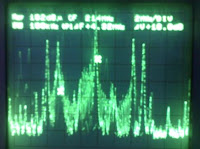1. Know the video camera.
2. Measuring the composite video on a video camera.
3. Determine the parameters of composite video.
B. Used Equipment
1 Video Camera
1 Oscilloscope 40 MHz and passive probe
An RCA cable connector - BNC (75W )
C. Circuit diagram
D. Basic Theory
A video camera is a camera used for electronic motion picture acquisition, initially developed by the television industry but now common in other applications as well. The earliest video cameras were those of John Logie Baird, based on the electromechanical Nipkow disk and used by the BBC in experimental broadcasts through the 1930s. All-electronic designs based on the cathode ray tube, such as Vladimir Zworykin's Iconoscope and Philo T. Farnsworth's Image dissector, supplanted the Baird system by the 1940s and remained in wide use until the 1980s, when cameras based on solid-state image sensors such as CCDs (and later CMOS active pixel sensors) eliminated common problems with tube technologies such as burn-in and made digital video workflow practical.
A typical analog camcorder contains two basic parts:
- A camera section, consisting of a CCD, lens and motors to handle the zoom, focus and aperture
- A VCR section, in which a typical TV VCR is shrunk down to fit in a much smaller space.
The camera component's function is to receive visual information and interpret it as an electronic video signal. The VCR component is exactly like the VCR connected to your television: It receives an electronic video signal and records it on video tape as magnetic patterns. These two sections are easily seen in the following photos.
A third component, the viewfinder, receives the video image as well, so you can see what you're shooting. Viewfinders are actually small, black-and-white or color televisions, but many modern camcorders also have larger full-color LCD screens. There are many formats for analog camcorders, and many extra features, but this is the basic design of most all of them. The main variable is what kind of storage tape they use.
Digital camcorders have all these same elements, but have an added component that takes the analog information the camera gathers and translates it to bytes of data. Instead of storing the video signal as a continuous track of magnetic patterns, it records the picture and sound as 1s and 0s. Digital camcorders are so popular because you can copy 1s and 0s very easily without losing any of the information you've recorded. Analog information, on the other hand, "fades" with each copy -- the copying process doesn't reproduce the original signal exactly. Video information in digital form can also be loaded onto computers, where you can edit it, copy it, e-mail it and manipulate it.
In the next section, we'll look at the heart of the camcorder, the semiconductor device that converts visual information into an electronic signal.
A comprehensive idea of a TV camera function is depicted in Figure 3-2 and 3-3. In Figure 3-2 the camera is aimed at scene / view so that the optical image can be focused on the target plate tube makers (pick-up tube). If you can look inside, you'll see the shadow-optical. The resulting video signal is shown by the oscilloscope waveform in the bottom left of the picture. Above is a monitor oscilloscope, which shows a reproduced image.
Figure 3-3. Block diagram that shows how the television camera composite video signal output channel. Here is shown the reflection and focusing the camera tube.
Details of the video signal waveform which is more fully shown by the block diagram in Figure 3-3. At first, blanking pulses added to signal the camera. They cause the signal amplitude to the black levels so retrace the MRV will not be visible. Further alignment pulses (sync) is inserted. Alignment (synchronization) is required to set the time & MRV horizontal and vertical.
Alignment (synchronization) is required to set the time & MRV horizontal and vertical.
Camera signal with blanking and synchronization (sync) is called a composite video signal (composite video signal). Sometimes the term is not a composite video signal (noncompoxite video signal) is used to identify the signal with blanking camera but without alignment. Standard output level of the composite video signal from the camera is 1Vpuncak-to-peak (pp = peak to peak) with the alignment pulses in the down position for negative polarity.
E. Experimental Procedure
1. Set-up devices like the picture above, connect the video camera out with input CRO.
2. Consolidate his instrument.
3. Set the appropriate CRO to be easily observed (MODE on the TV-H position and / or TV-V). When seeing a wave of horizontal synchronization MODE switch put on the TV-H position, while to see a wave of vertical sync put the MODE switch on the TV-V position.
4. Determine the synchronization pulses, blanking pulses, front and rear porch, and image information.
5. Image of the wave form and specify voltage.
F. Experiment Results and Analysis

Data Analysis

G. Conclusion
1. Blanking pulse causes the signal amplitude to the black levels so pengulangjejakan (retrace) the MRV will not be visible.
2. Toll-alignment (synchronization) is required to set the time & MRV horizontal and vertical.
3. Voltage is obtained between the mode switch on the TV-V = 1.2V while the mode switch on the TV-H = 2 V.
4. Alignment between the scanning process on the camera with a TV is called synchronization.
5. The components forming the composite video is 5, namely:
• image signal (luminance signal)
• horizontal blanking pulse
• vertical blanking pulse
• Horizontal synchronization pulse
• Vertical synchronization pulse




















